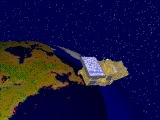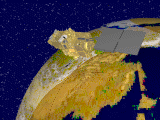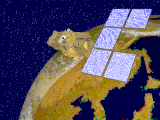Solar array deployment
After the satellite separates from the Ariane launcher, the flight software
progressively stabilizes it by slowing the rates of rotation about the different axes and
by pointing the earthward side vertically down.
The next step is to open the solar panels so that
these can start generating electrical current to power the onboard equipment and recharge
the batteries for the coming periods of darkness.
The solar array
consists of five large solar panels. During the launch phase, these are folded one on top
of the other on the satellite's "roof", since otherwise, the satellite would not
fit inside the Ariane rocket's payload fairing. The panels are secured in the stowed
position then released by firing pyrotechnic devices controlled by
the flight software.
Springs then deploy the solar array in two stages:
- primary deployment, which takes place off the coast of Newfoundland, releases the main
boom and the first of the panels,
- secondary deployment, which takes place while the satellite is within range of the
Japanese control stations, frees the remaining panels. The next step is to wait until the
next time the satellite crosses the ecliptic plane (i.e. the plane defined by the Earth's
rotation around the Sun). When this occurs, the array is set in rotation so that from this
moment on the array begins tracking so its panels remain perpendicular to the Sun's rays.
For a launch on 21 March, the day of the equinox, the ecliptic plane will be
intersected when the satellite crosses the equator.
Each step is monitored closely, and with a degree of apprehension, by the project
engineers since, without electricity, the satellite will survive no more than three or
four orbital revolutions (i.e. 300 to 400 minutes). If anything goes wrong at
this stage, there is very little time indeed to remedy the problem. For precisely this
reason, the project and operational teams spend a lot of time, prior to the launch,
rehearsing various scenarios to ensure that they are ready to respond very quickly in the
event of a mishap. Fortunately, problems at this stage are very rare.
The solar array deployment
sequence, illustrated below, is rather complex. The dark rings represent the circles of
visibility of the different TT&C stations used during the launch phase. To view an
animated deployment sequence, click on one of the thumbnail images.
Primary
deployment of the solar panels begins soon after the satellite separates from the Ariane
launcher.
(277 koctets) |

|
With the
satellite within range of the Katsuura TT&C station in Japan, secondary deployment of the solar panels is triggered
by the flight software.
(387 koctets) |

|
By the end of
the secondary deployment phase, all five solar panels are fully deployed. The array can
now be begin tracking so its panels remain perpendicular to
the Earth-Sun direction.
(350 koctets) |

|
The complete
sequence with slow motion during deployment phases.
(2,044 koctets) |
Complete sequence |
top of page, article

page updated on the 00-06-06


